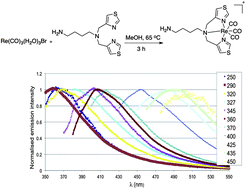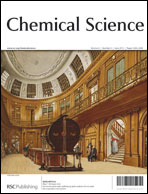Emission wavelength variation with changes in excitation in a Re(i)–bisthiazole ligand complex that breaks the Kasha–Vavilov rule†
Abstract
We report highly unusual photophysical properties of a fac-Re(CO)3–bisthiazole complex, which is shown to break the Kasha–Vavilov rule. Herein, we show that such a complex has unusual emission wavelength variation due to the presence of photo-induced isomerisation from the stable, ground-state N,N-bound thiazole complex to S,N- and S,S-donation in the photo-induced excited state. A triple excitation, triple emission profile along with extensive DFT calculations support this theory to showcase an unusual circumstance of suulfur donation to the fac-Re(CO)3 core upon luminescence. fac-Rhenium tricarbonyl complexes are extensively studied due to their fluorescent properties, high stability, and ready incorporation into conjugates with broad applicability in imaging and targeting. The spectroscopic features of the complex under study have broad fundamental interest while also offering potential for design of novel agents for use in biological imaging studies.


 Please wait while we load your content...
Please wait while we load your content...